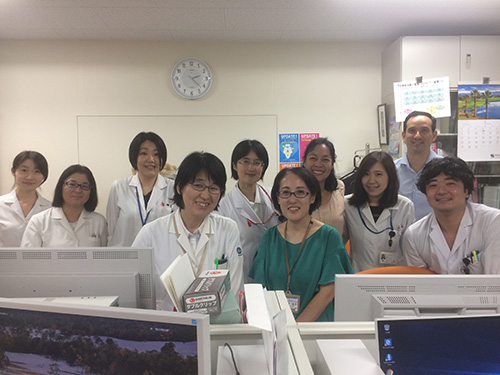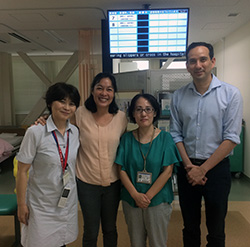A New TREAT Asia Study Will Examine Pregnancy and Birth Outcomes Among Women Living with HIV in East Asia
Antiretroviral therapy (ART) has brought dramatic improvements in life expectancy and quality of life for women living with HIV (WLHIV), as well as a greatly reduced chance of transmitting HIV to their children at birth. Some data from Western countries have shown WLHIV are now more likely to have children than they were earlier in the epidemic and that they have higher rates of unintended pregnancies.1-3

TREAT Asia staff with the staff of the AIDS Clinical Center clinic of the National Center for Global Health and Medicine
But data are limited on pregnancy frequency and outcomes among WLHIV in East Asian countries where women represent smaller proportions of those living with HIV compared to men. With the potential to achieve country-level elimination of new infant infections with testing and treatment of pregnant women, there are questions about how WLHIV view pregnancy in the context of having suppressed HIV viral load tests.
 (Left to right) Dr. Misao Takano, Ms. Tor Petersen, Dr. Junko Tanuma, and Dr. Jeremy Ross at the National Center for Global Health and Medicine (NCGM), Tokyo, during a TAHOD site visit, July 2018The backdrop for studying pregnancy among WLHIV in East Asia is of parallel demographic trends showing continued declines in overall birthrates in the general population.4 “Social and economic forces may also be impacting fertility and reproductive health among WLHIV in the region, and we hope to shed light on how declining regional birthrates may inform improved reproductive health support for them,” said Dr. Junko Tanuma of the National Center for Global Health and Medicine (NCGM) in Tokyo, Japan. Dr. Tanuma is lead investigator of a new TREAT Asia network study on pregnancy frequency, factors related to fertility, and pregnancy outcomes among WLHIV in Asia, supported through the US NIH’s IeDEA study.
(Left to right) Dr. Misao Takano, Ms. Tor Petersen, Dr. Junko Tanuma, and Dr. Jeremy Ross at the National Center for Global Health and Medicine (NCGM), Tokyo, during a TAHOD site visit, July 2018The backdrop for studying pregnancy among WLHIV in East Asia is of parallel demographic trends showing continued declines in overall birthrates in the general population.4 “Social and economic forces may also be impacting fertility and reproductive health among WLHIV in the region, and we hope to shed light on how declining regional birthrates may inform improved reproductive health support for them,” said Dr. Junko Tanuma of the National Center for Global Health and Medicine (NCGM) in Tokyo, Japan. Dr. Tanuma is lead investigator of a new TREAT Asia network study on pregnancy frequency, factors related to fertility, and pregnancy outcomes among WLHIV in Asia, supported through the US NIH’s IeDEA study.
The study will collect and analyze data from up to 400 WLHIV who became pregnant after HIV diagnosis, and were aged between 18 and 45 years old at the time of diagnosis. Participants will be from five clinical sites that contribute to TREAT Asia’s adult HIV cohort research in Japan, South Korea, Taiwan, Hong Kong SAR, and China.
“This study will allow us to learn more about the pregnancy and birth outcomes of women living with HIV in this part of the region, and provides an important opportunity to inform efforts to deliver integrated reproductive, obstetric and HIV health services,” said study Co-Principal Investigator Dr. Jeremy Ross, Director of Research for TREAT Asia.
1Huntington SE, Thorne C, Bansi LK, et al. Predictors of pregnancy and changes in pregnancy incidence among HIV-positive women accessing HIV clinical care. AIDS. 2013, 27:95-103.
2Salters K, Loutfy M, de Pokomandy A, et al. Pregnancy incidence and intention after HIV diagnosis among women living with HIV in Canada. PLoS One. 2017, 12:e0180524.
3Sutton MY, Patel R, Frazier EL. Unplanned pregnancies among HIV-infected women in care - United States. J Acquir Immune Defic Synd. 2014, 65:350-358.
4World Bank Data. Fertility rate, total (birth per woman). https://data.worldbank.org/indicator/SP.DYN.TFRT.IN